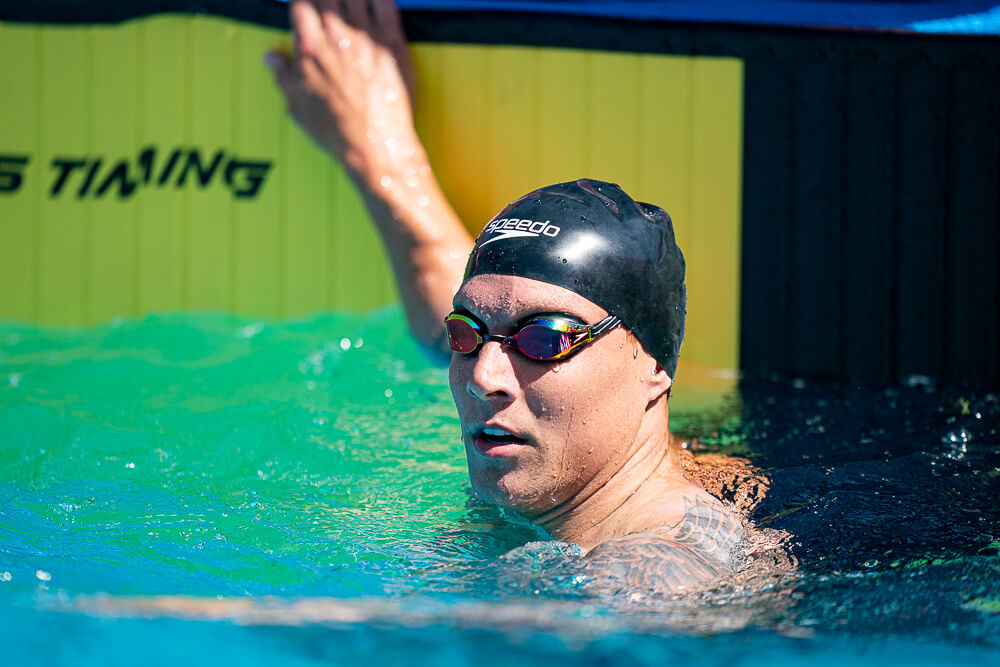Already in the Club, Can Caeleb Dressel Lead Assault on Sub-47s for 100 Freestyle?

Editorial content for the 2021 Tokyo Olympic Games coverage is sponsored by GMX7.
See full event coverage. Follow GMX7 on Instagram at @GMX7training #gmx7

Already in the Club, Can Caeleb Dressel Lead Assault on Sub-47s for 100 Freestyle?
By Daniel Zeng, Swimming World Intern
Year after year, new training methods and the continuous will to improve allow swimmers’ times to drop, seemingly without end. Once a barrier is broken, we immediately begin to envision how long it will be until that time is the norm.
The 100-meter freestyle is certainly an event which is defined by barrier-breaking performances, dating to Jim Montgomery becoming the first man to crack the 50-second mark in 1976. Today, most of the world’s fastest male swimmers swim the event – at their peak – in the 47-second range. At this summer’s Olympic Games in Tokyo, it could take 47-mid to reach the final of the 100 freestyle.
From a flat start, Frenchman Alain Bernard first swam past the 47-second barrier in 2009, joined months later by Cesar Cielo. Caeleb Dressel posted a 46.96 10 years later, clocking just .05 off of Cielo’s still-standing world record, in a textile suit. It is worth noting that Bernard and Cielo posted their times at the height of the super-suit era.
With Bernard and Cielo gone, Dressel is the only current male swimmer in the exclusive sub-47 club. Australians Kyle Chalmers and Cameron McEvoy have been the closest to Dressel since the end of the super-suit days, swimming 47.08 and 47.04, respectively. Despite McEvoy’s time being the second-fastest ever in a textile suit, he was outside the top-25 worldwide the past two years, while Chalmers, the reigning Olympic champion, has consistently been there for the last five years, proving he is Dressel’s top competition ahead of Tokyo.
Although only three men have ever been under 47 in the individual 100 freestyle, multiple athletes have split faster at both the Olympics and World Championships on relays. While a majority of those sub-47 splits were turned in during the super-suit era, three swimmers – Chalmers, Duncan Scott and Zach Apple – were sub-47 at the 2019 World Championships.
An absence of 46-second relay splits in the years after the super suits indicates the assistance the suits provided and the fact that swimmers and coaches had to adjust to new training methods to produce the same results the suits enabled.
The following are some of the factors to consider, besides training advancements, on what propelled these swimmers to drop time.
Increased Depth
The depth of the 100 freestyle is, arguably, the strongest it has ever been. The battle for the two individual berths from the United States to the Tokyo Games will be a slugfest, with Dressel as the obvious frontrunner and a number of names capable of advancing. Beyond the U.S., Russia boasts an impressive roster and Chalmers leads the Australian contingent. With a slim margin for error in major competition, times are faster through the rounds, with the opposition pushing one another to new levels.
Catching up from behind
Whether on a relay or in the individual 100 free, rallying from behind can push swimmers to faster times. Especially in a relay, where a team is depending on you, adjusted times from flying starts can be found to be faster than individual performances. Jason Lezak on the end of the men’s 400 freestyle relay in Beijing is a notable example, as he had to rally the United States from a significant deficit against France. That swim, too, saved Michael Phelps‘ chase for eight gold medals.
Looking forward, there is a stream of new talent that is capable of furthering the 100 freestyle. While Dressel and Chalmers lead the pack, Scott and Russians Kliment Kolesnikov and Andrei Minakov are expected to have a major impact on the event.
When the Trials season opened, there were questions concerning the speed that would be seen, particularly due to uncertain training programs from the COVID-19 impact. Nonetheless, there have been some impressive swims despite the circumstances. Those swims bode well for this summer’s Tokyo Olympics, where Dressel will challenge the world record and could bring others along with his front-end speed.
No one exactly knows when breaking 47 will become the norm, but the future is looking bright.
All commentaries are the opinion of the author and do not necessarily reflect the views of Swimming World Magazine nor its staff.





Let’s go